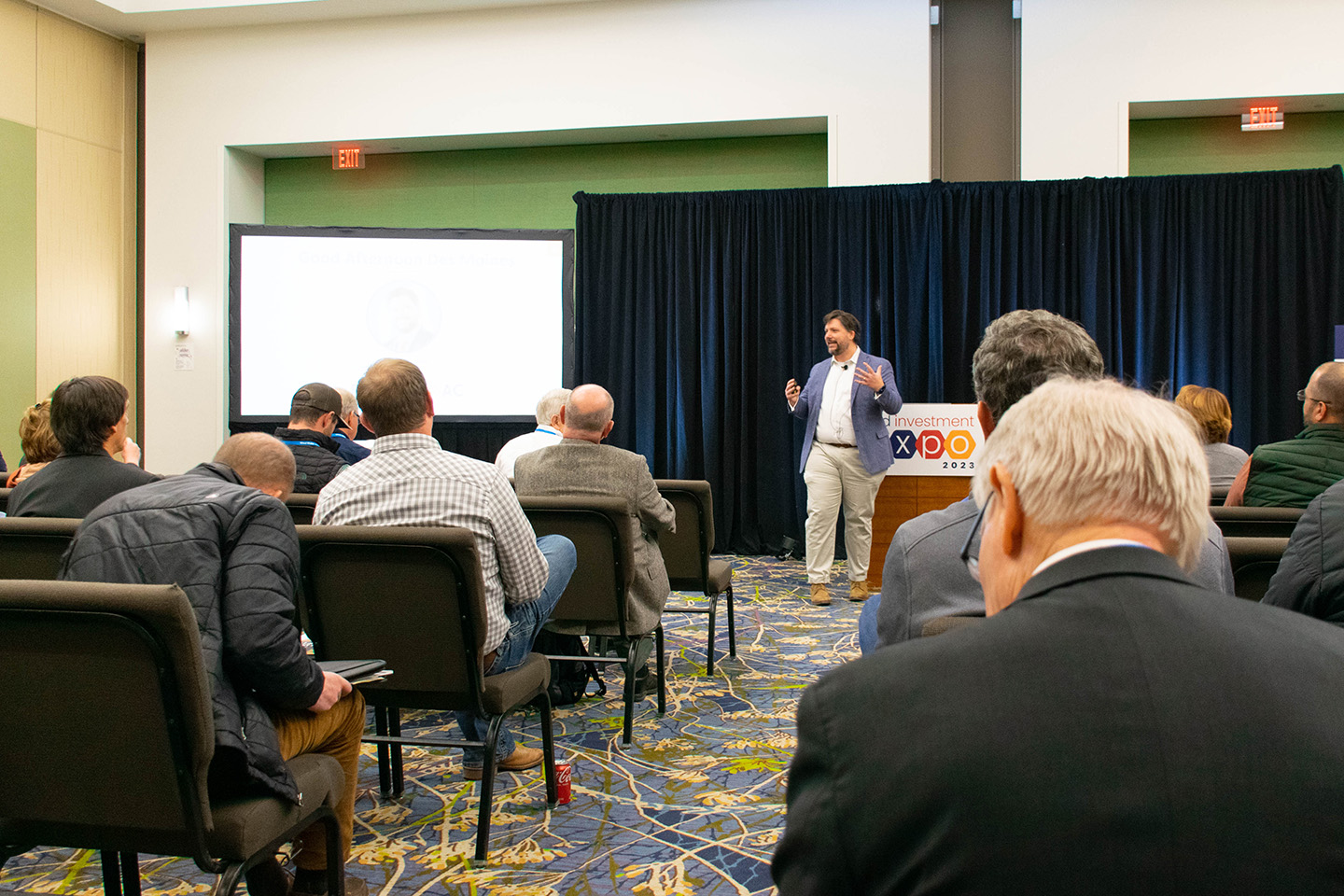
(Photo: Jeff Hutton/Iowa Soybean Association)
2023 Land Expo Conference held
January 12, 2023
Land values, interest rates and the overall economy were part of the discussion during the Land Investment Expo in Des Moines this past week.
Numerous presentations were held on a whole host of topics of concern to farmers and landowners.
FCS perspective
Jim Knuth, senior vice president at Farm Credit Services of America, says going into 2023, land values in Iowa are at an all-time high. But who is driving the market?
“The trend is really clear that local capital and competition is driving the market,” he says.
And given current commodity prices, farmers are able to secure more land, when available.
But Knuth says the trajectory of land values, are starting to moderate a bit, especially with concerns over inflation and interest rates.
“Typically, higher commodity prices are the primary driver of cash rents, not land values,” he says. “But in 2022, commodity prices were the primary driver of both.”
Knuth says interest rates, despite going up in the past year in at attempt to curb inflation, would impact land values. But in 2022, it had a minimal impact.
“More farms are being purchased for cash than ever before,” he says. “There’s the old adage that successful farmers are asset rich and cash poor. Today, they are asset rich and cash rich. Land values have risen and there is more equity.”
Knuth says there are several factors that are impacting land values. Past patterns would suggest that a drop in values and/or land purchases.
The example, he provides, followed the 2012 peak in the ethanol boom, and then a “rough ag cycle from 2015-20.”
But 80 percent of the land is owned “free and clear” Knuth says. “So we have a lot of no-debt and low-debt acres in the state of Iowa.” The supply of land available for sale, he says, is not as prevalent as in years past.
“It would take a significant ag cycle to pressure more land onto the market. That somewhat lower supply of land will continue in the years ahead.”
But Knuth acknowledges that interest rates are up significantly – “the steepest increase we’ve seen in decades.”
And in the past two years, inflation has been a concern, thus the spike in interest rates.
“The Federal Reserve became very diligent, aggressive, hawkish to fight inflation. We ended the year at 7.5%.”
The prime lending rate was at 3.25% at in 2020.
Knuth says the best forecast for this year and the near future is that the Federal Reserve will remain aggressive on inflation.
“What we believe will happen is that short-term interest rates will rise moderately,” he says. “Long-term rates will remain relatively stable, but is all depends on the Federal Reserve and inflation.”
Knuth says 2022 seems to have been the peak of the “third super cycle” in modern grain agriculture production.
The late 1970s and period around 2010-12 and the ethanol boom were the previous two super cycles.
“As we go into 2023 and beyond, we are navigating the road from the peak,” Knuth says. “The question is how long, how short, how steep, how gradual will things play out in the months ahead?”
Right now, he says, farmers are experiencing their best margins.
“We have unprecedented levels of liquidity cash, working capital. Grain production agriculture is on very solid financial footing.”
While Knuth says 2023 appears to be another profitable year, “we can look forward to 2023 and we can see a margin squeeze … it’s not likely we’ll see those record margins.”
Knuth says it’s important for farmers and landowners to follow this philosophy: Conservative during good times in order to be courageous and reliable in tough times.
He adds that “this is a good time to have both hands on the wheel.
“As we stand here today, maintaining your liquidity position, your working capital and risk-bearing ability” is key. “Don’t pay cash for everything; use appropriate financing.”
Overall, Knuth says, “grain production agriculture is in a very, very solid financial position. We’re well positioned for the journey ahead and that’s good for farmers, good for Iowa and good for agriculture.”

Farmer Mac view
Jackson Takach, chief economist for Farmer Mac, says the United States has had two decades of low inflation rates, but that’s not the case now.
“Post-Covid, there’s been a huge spike in inflation and prices were rising way too fast,” he says. “The Federal Reserve had to take action through raising interest rates
“It’s been a very tumultuous time.”
Beyond Covid, so many factors are playing a role in the current economic state.
Takach points to the labor market as an example
“Typically 3% of all jobs are open,” he says. “Right now, we’re looking at 6%. There’s just not enough people to fill all the jobs that are open. People have not come back to work after Covid.”
He says employees who are willing to work have a lot of power, which in turn hurts employers who have to raise prices on goods and/or services.
“We have more people in the labor force than in February 2020 but more openings,” Takach says. “And it’s not just parts of the U.S. Every state is dealing with the problem.
“Prices and wages are trying to keep up with each other.”
The Federal Reserve is concerned about that, he says, along with inflation – thus the need to raise interest rates.
Takach says while it’s not clear a recession is coming, it is going to be challenging in the next several months.
As to land, Takach says while prices have jumped throughout the United States, “the Midwest was really the hot center of land appreciation in 2022.”
He echoed Knuth’s message that a healthy ag economy has certainly contributed to those prices.
Back